When these young teenage girls first entered the sniper school, they were not sure if they would be able to pull the trigger at all. Hard training, both mentally and physically, however, turned them into beings devoid of any doubts. Their job was to kill. What did they have to go through to hit the front?
After the Third Reich attacked the USSR, Stalin quickly began to appreciate the military potential of women. They began to be admitted not only to auxiliary service, but also to direct combat. In the years 1941-1942, the course of the war thinned the ranks of the men sent to the front so much that the ladies began to be directly encouraged to take their place. They were trained for a variety of tasks, from piloting military aircraft, through infantry, to sniper shooting.
Sniper training began in 1942. Initially, only a handful of future instructors were allowed to study, and after completing the course, they were to pass their knowledge on to a much larger number of candidates for hunters. As Roger D. Markwick and Euridice Charon Cardona write in their work on Soviet women on the fronts of World War II, the sniper movement was popularized by Stalin himself, who on May 1, 1942 called them the glorious torturers of the German occupiers.
A little over a year later (May 21, 1943), women were trained on such a scale that a suitable facility was needed - the Women's Sniper Training Center, whose commandant was Nora Chegodayeva, a veteran of the Spanish Civil War. It was in this facility that the lion's share of female snipers serving on all fronts was educated.
Perfect sniper rifle, which is what?
The local branches of the Komsomol, i.e. the communist youth organization, played a key role in the recruitment process. A good candidate should have been between 18 and 25 years old. She had to be educated at least at the 7th grade. The future sniper rifle was expected to have no "family problems". Her health was also important - previously sustained wounds and (of course) vision problems were excluded from possible training. To serve as a sharpshooter, you need true falconry eyesight. So that there was no doubt in this regard, the girls underwent strict medical examinations.
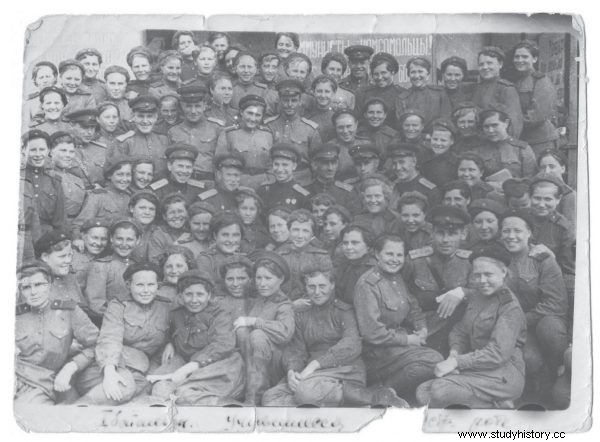
Students of the sniper school with instructors (photo:press materials of the Znak Horyzont publishing house)
However, with regard to health and age, exceptions were made. Two of them are quoted by Luba Winogradowa in her new book “Sniperki. Girls from the Red Army ” :
Tania Baramzina, "unpleasant, simple girl, terrible talker", was a zealous communist. Everyone was surprised that he could shoot with glasses. [The other shooters] kept wondering how it was possible that despite having a visual impairment, she was accepted into a sniper school. In the end, they came to the conclusion that it was because of their work for the party or for the Komsomol.
Due to her deteriorating eyesight, Tania was moved to Communications. She became famous after her heroic death. She defended the bunker with the wounded until the very end. The Germans captured her, tortured her, and finally shot her with an anti-tank rifle, as one of the wounded told her.
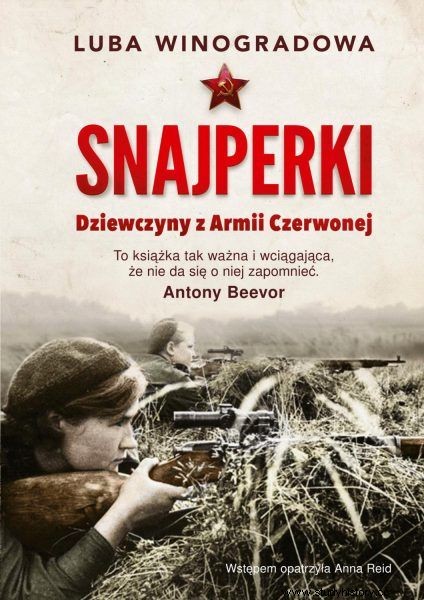
The second exception described by Winogradowa was Nina Petrov. The woman, affectionately called "Mama Nina" in the unit, had 107 Germans on her account. According to the enlistment criteria, it was completely unsuitable for a sniper rifle - when the Second World War broke out, she was already 48 years old. However, thanks to her enormous skills (she had been training shooting for a long time), she not only killed the enemy herself, but also trained as many as 500 of her successors!
Once the women were recruited, the local Komsomol was supposed to equip them with clothes, shoes, a towel, a spoon, a mug and a bag for personal belongings. Many of the girls went to the sniper school as enthusiastic and somewhat naive volunteers, who soon found out that serving in the Red Army was no joke.
Farewell to curls
The service began with the quarantine and the march of a group of women of all nationalities living in the USSR to the bathhouse, where hairdressers were waiting for them. It was not a joyful moment - long curls and braids fell to the ground, giving way to practical short hairstyles. Uniform sorts also left a lot to be desired. Instead of panties, women were assigned wide, long underwear, reaching almost to the knees, made of sheets and tied at the waist with a special belt. In addition, they were entitled to a men's T-shirt with long sleeves tied at the neck, also made of sheets, and onuce. In addition, boots with wide uppers, cotton trousers, a T-shirt, a jacket and an earhook. With their hair cut and dressed up, they looked like boys from a distance.
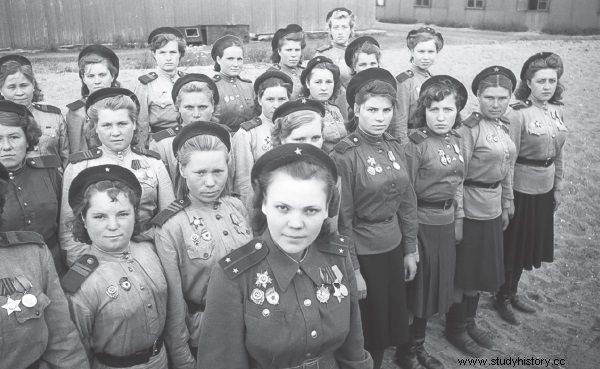
A platoon of Soviet snipers (photo:press materials of the Znak Horyzont publishing house)
Nevertheless, as Julia Żukowa recalled years later, whose statement was quoted by Luba Winogradowa, the very haircut and uniforms made the female soldiers wear differently. Appeals at six in the morning and making a hard wooden bed without the slightest wrinkle on the sheets quickly became part of the daily routine. There was only one thing the girls were not getting used to.
Although the recruits received fair rations of food, they were accompanied by constant hunger. The portions were "front" - three courses, three times a day, with meat and fat being served regularly. The constant physical exertion expected of them, and the fact that meals were to be eaten in a hurry because another group was waiting for their turn, kept the soldiers hungry. This feeling lowered morale to such an extent that some of the women decided to steal food.
During the course, the problem was also with medical care, limited in fact to quarantine and several vaccinations (for tetanus, cholera and dysentery). When Julia Żukowa, in training in 1944, contracted boils (very painful bacterial inflammation of the hair follicles) under a broad military belt, she was suggested to turn to ... folk medicine.
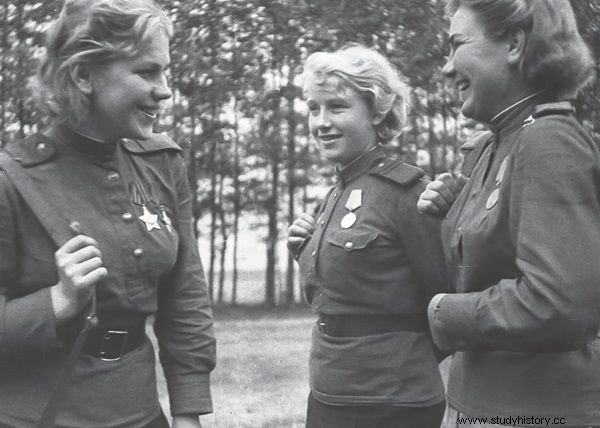
First from the left one of the most famous Soviet sniper rifle Roza Szanina (photo:press materials of the Znak Horyzont publishing house)
When no remedies worked and she was still suffering from ulcers, the surgeon finally intervened, who in this case acted rather like a butcher. Without any anesthesia, he cut open and cleaned the boils, then washed everything with iodine. The student did not receive any painkillers or antibiotics. Instead, she had to go back to training immediately, crawling and running and climbing with a belt around her wounds.
Fifteen hours of mud crawling a day?
The day plan was strict and full. Winogradowa describes it in some detail . It started with a wake up at six, then it was time for a toilet in the river, 2 kilometers away, and a quick meal, which was finished with the command "get up from the table". Those who talked over the bowl instead of eating went hungry later. After these preparations, intensive training could begin:
In the barracks, the students learned theories, including ballistics, and the equipment. The rest of the time they dealt with drills and shooting. They spent long hours outside regardless of the weather. They were taught how to dig in in various ways, mask and stay on the lookout for a long time, how to move in unfamiliar terrain and crawl on their stomachs. In addition, they also took part in special classes for snipers - training in observing and remembering, as well as eye and hand exercises. They were also taught hand-to-hand combat and grenade throwing.
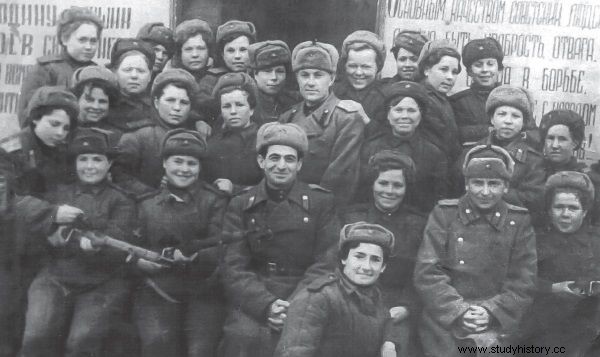
A sniper platoon with instructors (photo:press materials of the Znak Horyzont publishing house)
Physical training was just as important as the above skills. After all, in order to easily carry a considerable rifle, women had to gain vigor. Therefore, they started their exercises on the training ground with their own excavation of deep tranches and trenches, as well as with the preparation of shooting positions and fortifications. Their main tool for this work were shovels, i.e. shovels several dozen centimeters long. So at the same time they exercised their muscles and became skilled at using one of their later basic tools.
Also, constantly crawling, regardless of snow and mud, had its purpose. Zhukova once tried to deceive Lieutenant Mażnow, her commander, whom the students warmly hated. In autumn, the training ground where they ran was full of mud and puddles. When the man gave the command "go down, crawl" Julia was in front of a huge puddle, which she decided to deftly avoid by taking a few steps to the side.
This infuriated Mażnow, who noticed her slight maneuver and ordered her to return to the previous place and crawl through the middle of the puddle. Winogradowa explains that such treatment was to prepare the girls for the conditions that would prevail at the front. If Zhukova, being on the first line, instead of immediately falling to the ground and hiding herself, had started avoiding puddles, she probably would not have survived it.

Under all conditions
The absolute most important element of the training, however, was learning how to shoot. The girls, many of whom were holding a rifle for the first time in their lives, had to be able to use it in all situations and conditions. Therefore, the students shot in every position, standing, lying, sitting, kneeling, with or without support. After all, the sniper hides and hunts the enemy in all sorts of places and conditions.
The course also included shooting various targets, both masked and fully visible, but in motion, for example. The female soldiers were trained for offensive battles, in line with the emerging new situation at the front. Daily training lasting up to fifteen hours, multi-kilometer marches in full uniforms and equipment in all weathers, the art of camouflage and shooting were to prepare them for battle in the best possible way, according to the principle "the harder the training, the lighter the battle".
Some of the superiors liked to play with their power and to demean the students. Some of the classes were conducted by the elder , i.e. women from earlier years who had already completed the training, but stayed to watch over the next groups. The future sniper rifles had a particularly bad memory of the elder Vashchenko, who liked to torment them.
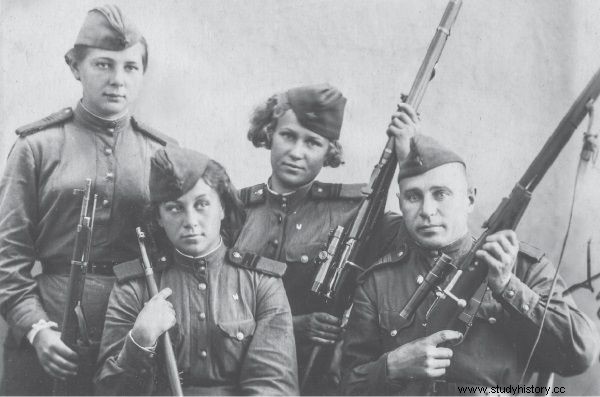
Soviet snipers (photo:press materials of the Znak Horyzont publishing house)
When the girls returned to the barracks after a day of hard training, she made them sing or crawl. Once, when they were only a few hundred meters away from the quarters, as described by Wingoradova, she ordered them to tear across the ditch, and then she repeatedly ordered "fall, crawl, rise". At this "drill" she was caught by a senior commissioner who immediately ordered the students to leave, and she herself started after the elder . Although she practiced it solidly on the sidelines, the whole school found out about it immediately. It was an open secret that many such commanders, when they reached the front with their men, died from mysterious, stray bullets.
After the women had completed the course, it was time for the exams. They were not based on written theorizing, but were designed to show in practice what future sniper rifles had learned at school. The examiners watched and assessed how the students shoot, crawl, use the art of camouflage, dig trenches, give first aid, protect themselves from gas weapons, fold and unfold their weapons, and what decisions they make on the battlefield. When they received positive feedback, they could finally go to the front, where their knowledge was verified by life.
Information sources:
- Markwick R.D, Cardona E. Ch., Soviet Women on the Frontline in the Second World War , Palgrave McMillan 2012.
- Miecik I.T., Katyusha with a bayonet, PWN 2014.
- Pegler, M., History of Military Sniper , Bellona 2008 ..
- Winogradowa L., Snipers. Girls from the Red Army , Horizon 2018 sign.
